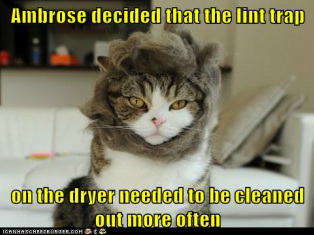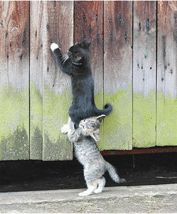Particle Filters...The lint trap of the symbolic washing machine universe!

Have a non linear system in less than 5 dimensions that you need to model? Tried and failed with the Kalman filter?! Have no fear, the Particle Filter is here! Using monte carlo simulations of sample data from the state and measure updates, you can approximate the the true behavior of even highly non-linear systems! See the matlab tutorials below!
| particle_filter_student_dave_basic_ex1.m | |
| File Size: | 6 kb |
| File Type: | m |
%Student Dave's particle filter tutorial
%In this tutorial, The Frequentisian Ninja Clan has just run into the mysterious Quail.
%The Quail was just doing it's typical magical quail stuff throughout the forest like, I
%dunno, freeing catapillars from evil monkey spells.
%The ninja clan, knowing the impossible agility of the Quail, began to
%stretch out and prepare for attack. During which the Quail mediated and
%generated a highly non-linear flight model with strong illusions (i.e. weird measurements :P) and takes off!
%
%The student ninja's make chase but, only knowing linear algorithms, they
%fail very quickly. However, the Master Frequentisian Ninja knows the
%particle filter, and after a cognitively and physical exhaustive, epic
%chase, the Master catches the Quail, and takes it back to their secret
%Dojo.
%Here, we learn this master skill, known as the particle filter, as applied
%to a highly nonlinear model. :)!
%Adapted from Dan Simon Optimal state estimation book and Gordon, Salmond,
%and Smith paper.
%% clear everything
clear all
close all
clc
%% initialize the variables
set(0,'DefaultFigureWindowStyle','docked') %dock the figures..just a personal preference you don't need this.
x = 0.1; % initial actual state
x_N = 1; % Noise covariance in the system (i.e. process noise in the state update, here, we'll use a gaussian.)
x_R = 1; % Noise covariance in the measurement (i.e. the Quail creates complex illusions in its trail!)
T = 75; % duration the chase (i.e. number of iterations).
N = 10; % The number of particles the system generates. The larger this is, the better your approximation, but the more computation you need.
%initilize our initial, prior particle distribution as a gaussian around
%the true initial value
V = 2; %define the variance of the initial esimate
x_P = []; % define the vector of particles
% make the randomly generated particles from the initial prior gaussian distribution
for i = 1:N
x_P(i) = x + sqrt(V) * randn;
end
%{
%show the distribution the particles around this initial value of x.
figure(1)
clf
subplot(121)
plot(1,x_P,'.k','markersize',5)
xlabel('time step')
ylabel('flight position')
subplot(122)
hist(x_P,100)
xlabel('flight position')
ylabel('count')
pause
%}
%the functions used by the Quail are:
% x = 0.5*x + 25*x/(1 + x^2) + 8*cos(1.2*(t-1)) + PROCESS NOISE --> sqrt(x_N)*randn
% z = x^2/20 + MEASUREMENT NOISE --> sqrt(x_R)*randn;
%generate the observations from the randomly selected particles, based upon
%the given function
z_out = [x^2 / 20 + sqrt(x_R) * randn]; %the actual output vector for measurement values.
x_out = [x]; %the actual output vector for measurement values.
x_est = [x]; % time by time output of the particle filters estimate
x_est_out = [x_est]; % the vector of particle filter estimates.
for t = 1:T
%from the previou time step, update the flight position, and observed
%position (i.e. update the Quails position with the non linear function
%and update from this position what the chasing ninja's see confounded
%by the Quails illusions.
x = 0.5*x + 25*x/(1 + x^2) + 8*cos(1.2*(t-1)) + sqrt(x_N)*randn;
z = x^2/20 + sqrt(x_R)*randn;
%Here, we do the particle filter
for i = 1:N
%given the prior set of particle (i.e. randomly generated locations
%the quail might be), run each of these particles through the state
%update model to make a new set of transitioned particles.
x_P_update(i) = 0.5*x_P(i) + 25*x_P(i)/(1 + x_P(i)^2) + 8*cos(1.2*(t-1)) + sqrt(x_N)*randn;
%with these new updated particle locations, update the observations
%for each of these particles.
z_update(i) = x_P_update(i)^2/20;
%Generate the weights for each of these particles.
%The weights are based upon the probability of the given
%observation for a particle, GIVEN the actual observation.
%That is, if we observe a location z, and we know our observation error is
%guassian with variance x_R, then the probability of seeing a given
%z centered at that actual measurement is (from the equation of a
%gaussian)
P_w(i) = (1/sqrt(2*pi*x_R)) * exp(-(z - z_update(i))^2/(2*x_R));
end
% Normalize to form a probability distribution (i.e. sum to 1).
P_w = P_w./sum(P_w);
%{
figure(1)
clf
subplot(121)
plot(P_w,z_update,'.k','markersize',5)
hold on
plot(0,z,'.r','markersize',50)
xlabel('weight magnitude')
ylabel('observed values (z update)')
subplot(122)
plot(P_w,x_P_update,'.k','markersize',5)
hold on
plot(0,x,'.r','markersize',50)
xlabel('weight magnitude')
ylabel('updated particle positions (x P update)')
pause
%plot the before and after
figure(1)
clf
subplot(131)
plot(0,x_P_update,'.k','markersize',5)
title('raw estimates')
xlabel('fixed time point')
ylabel('estimated particles for flight position')
subplot(132)
plot(P_w,x_P_update,'.k','markersize',5)
hold on
plot(0,x,'.r','markersize',40)
xlabel('weight magnitude')
title('weighted estimates')
%}
%% Resampling: From this new distribution, now we randomly sample from it to generate our new estimate particles
%what this code specifically does is randomly, uniformally, sample from
%the cummulative distribution of the probability distribution
%generated by the weighted vector P_w. If you sample randomly over
%this distribution, you will select values based upon there statistical
%probability, and thus, on average, pick values with the higher weights
%(i.e. high probability of being correct given the observation z).
%store this new value to the new estimate which will go back into the
%next iteration
for i = 1 : N
x_P(i) = x_P_update(find(rand <= cumsum(P_w),1));
end
%The final estimate is some metric of these final resampling, such as
%the mean value or variance
x_est = mean(x_P);
%{
%the after
subplot(133)
plot(0,x_P_update,'.k','markersize',5)
hold on
plot(0,x_P,'.r','markersize',5)
plot(0,x_est,'.g','markersize',40)
xlabel('fixed time point')
title('weight based resampling')
pause
%}
% Save data in arrays for later plotting
x_out = [x_out x];
z_out = [z_out z];
x_est_out = [x_est_out x_est];
end
t = 0:T;
figure(1);
clf
plot(t, x_out, '.-b', t, x_est_out, '-.r','linewidth',3);
set(gca,'FontSize',12); set(gcf,'Color','White');
xlabel('time step'); ylabel('Quail flight position');
legend('True flight position', 'Particle filter estimate');

